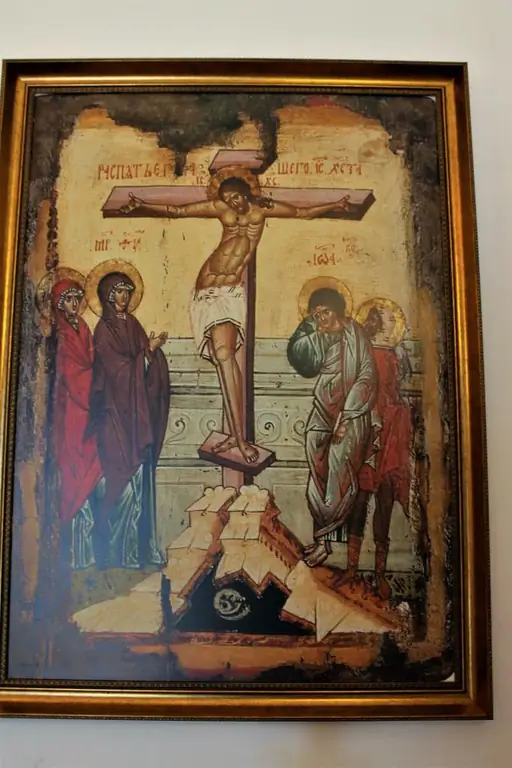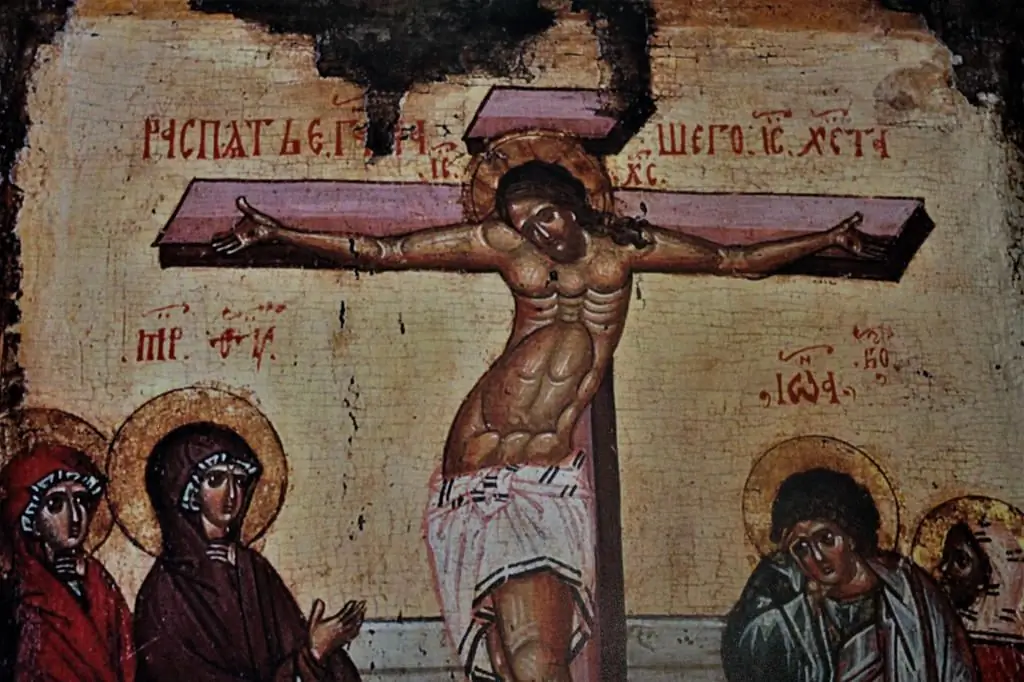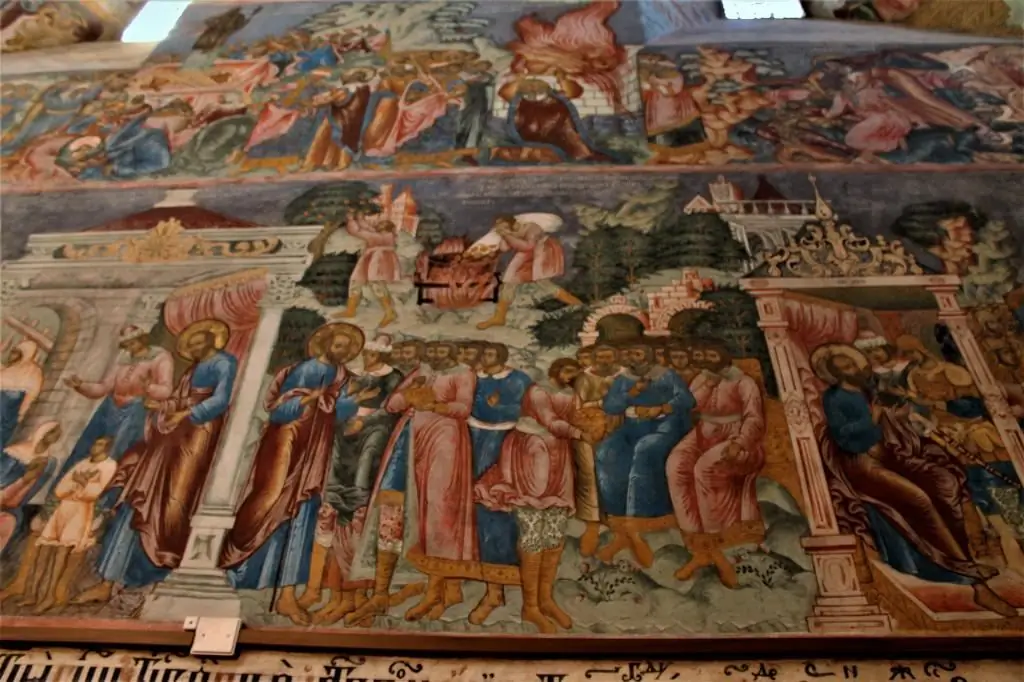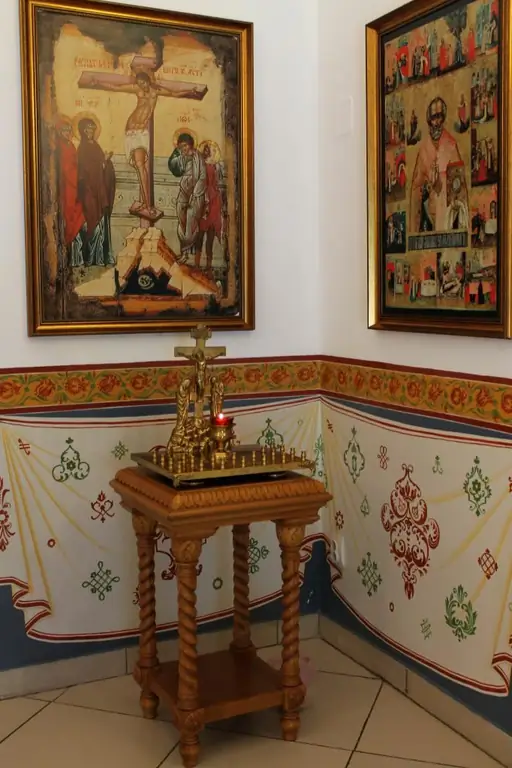- Author Miguel Ramacey [email protected].
- Public 2023-12-17 06:11.
- Last modified 2025-01-24 21:21.
In icon painting, there are a large number of images that strongly influence the emotions and perception of believers. One of them is the icon "The Crucifixion of Jesus Christ", a photo of which is not difficult to see in any Orthodox gallery, and the image itself is in almost every church.
The plots of icon-painting images arose at the dawn of the formation of Christianity not by chance. The icons fulfilled the mission of enlightenment, in the literal sense they were illustrations explaining religious subjects. They told the newly converted about important events and milestones in the formation of Christianity. This dictated the appearance of most plots in icon painting, of course, with the exception of a simple depiction of saints, although it was often accompanied by miniatures explaining their deeds.
What does the look look like?
The way the icon of Christ the Savior "Crucifixion" looks like is not unambiguous, the image is written in different ways. The authors use various artistic techniques, which, of course, have their own meaning.
The first thing that distinguishes the images is the background. Some authors use dark, gloomy tones, others prescribe a crucifix on gold. The dark background simultaneously emphasizes the tragedy of what happened and conveys the actual events, because the sun went dark when Jesus was crucified.

Golden background is used more often by icon painters. This shade is a symbol of triumph, the very act of saving humanity through the sacrifice of Jesus. It also symbolizes the greatness of the feat of the Savior in the name of people, his victory over death. The victory of Jesus is also symbolically expressed in one more detail - a skull in the ground, inscribed at the base of the crucifix.
Besides Christ, the icon depicts other characters that complement its storyline. Their number also does not remain constant. On each image, only the Mother of God is canonically present, the rest of the figures and their number change. The sizes shown are also different. The difference in size conveys their status, meaning and importance.
Who else is depicted on the icon?
The icon "The Crucifixion of Our Lord Jesus Christ" invariably contains the figure of the Mother of God in its plot. As a rule, the Mother of God is depicted by icon painters on the right hand of Jesus.

In addition to the Mother of God, the plot of the image is often complemented by figures:
- John the Theologian;
- thieves taken by Jesus into heaven;
- Roman soldiers.
The heavenly powers in the form of angels are often depicted at the top of the image. In complex icon-paintings filled with details,rocks are written behind the crucifix, symbolizing the earthquake that occurred during the execution. On wall frescoes, the plot is often supplemented by the symbolic sun and earth painted in the upper part along the edges.
The complexity of execution and the fullness of details are typical for old images that carried an educational mission. At the end of the Middle Ages, the icon of Jesus Christ "The Crucifixion" was no longer overloaded with details, the emphasis was on the central figure, that is, on the most important event, which the plot of the image tells about.
How has the image of the Lord changed over time?
The plot of the crucifixion is one of the key ones in Christianity. Accordingly, icon-paintings on this topic were among the first to appear. Of course, the icon of Jesus Christ "The Crucifixion" over the centuries has changed in appearance, not only in how many details and characters were depicted on it. The very image of the Savior also changed. The icon painters of the early schools and the Middle Ages painted the Lord in different ways.

Until the end of the 9th century and the beginning of the 10th century, the icon of Jesus Christ "The Crucifixion", although performed mainly in gloomy colors, the Lord himself looked alive and triumphant on the image. The palms were open, and the arms were wide open as if Jesus was trying to hug everyone approaching the icon. After the 10th century, the icon of Jesus Christ "The Crucifixion" changes, the Lord is increasingly depicted dead, with folded or drooping palms. Such an interpretation symbolizes the greatness of the feat of the Lord, the act of his redemptive death, its importance.
What is the meaning of the icon?
Godbelievers pray for everything, with every sorrow and misfortune they go to the images of Jesus. But not every image has the same meaning as an icon depicting the act of crucifixion.

This image not only invariably impresses believers, it affects their emotions. The icon is a kind of short gospel, because it tells about distant events that formed the basis of the Christian faith. This is a kind of "educational program" for those who gravitate towards the Lord, but have no knowledge of Christianity. That is, the image of the crucifixion is extremely important today, because decades of lack of spirituality in Russia, years spent, without exaggeration, in idolatry, called partisanship, have practically deprived people of basic, fundamental knowledge of the foundations of Christianity. Parishioners do not always even understand who exactly is depicted on any icon, and frescoes are often perceived only as a kind of decoration for church walls.
Accordingly, the meaning of the image in modern temples is similar to what it was centuries ago. The icon performs an educational mission and, of course, strengthens the faith of the parishioners, influencing their emotional perception, impressing. For this reason, the image is one of the first that believers see when they enter restored or reopened churches.
How does the image help?
There are many images of the Lord, and each of them has its own story. With its content, an understanding of who and what will help prayer in front of a specific icon is connected. Icon "The Crucifixion of Jesus Christ" in whathelps? In gaining and maintaining faith, in repentance and entering the righteous path.
People who feel guilty, tormented by remorse and remorse have been going to this image since time immemorial. An oppressive emotional state can be caused by any reason. It is not at all necessary for the occurrence of a feeling of remorse to commit a bad deed. Repentance often haunts people who have never done anything bad to anyone in life. An oppressed emotional state comes when there is no understanding of the meaning in one's own life, an awareness of spiritual emptiness.
Faith in the Lord saves from such emotions. And prayer in front of the icon depicting the act of crucifixion from time immemorial helps in repentance and fills the soul with the light of faith and kindness.
How to pray before the image?
Of course, canonical services are held in front of the icon depicting the crucifixion, the troparion is read and other church actions are performed. It is quite possible for an ordinary parishioner to pray in his own words, because the main condition for turning to the Almighty is sincerity, directness of heart and purity of thoughts.

You can use this example of a prayer:
“Jesus Christ, Lord Almighty and All-Merciful! I humbly beg you, Savior of human souls. And I give you my life. To abide in your bosom and see eternal life. Avoid hell and the temptations that lead to it. Fight bad thoughts. The wicked avoid thoughts and deeds. Accept me, Lord, teach me, enlighten me, guide me on the path of righteousness and have mercy!Amen.”






